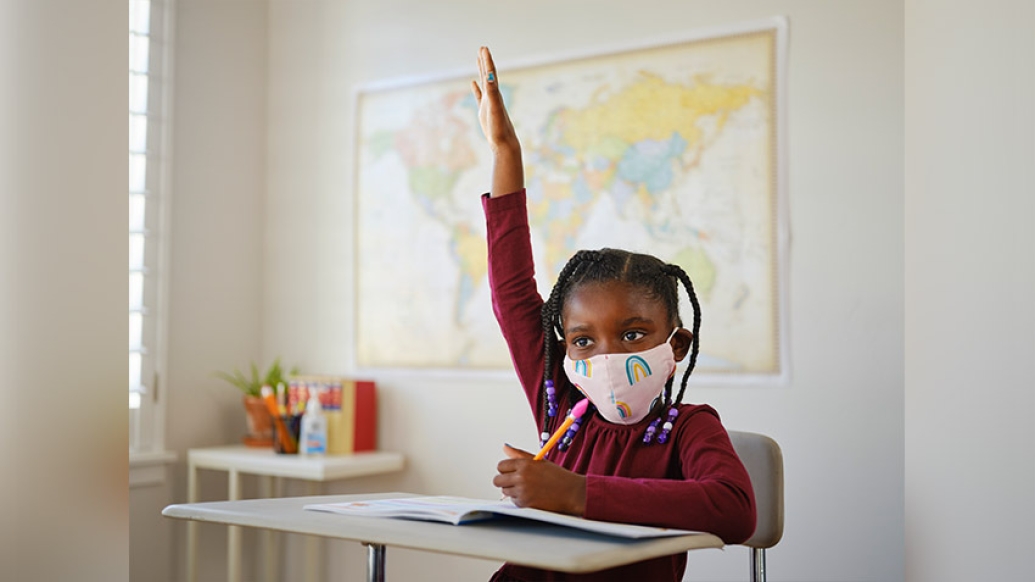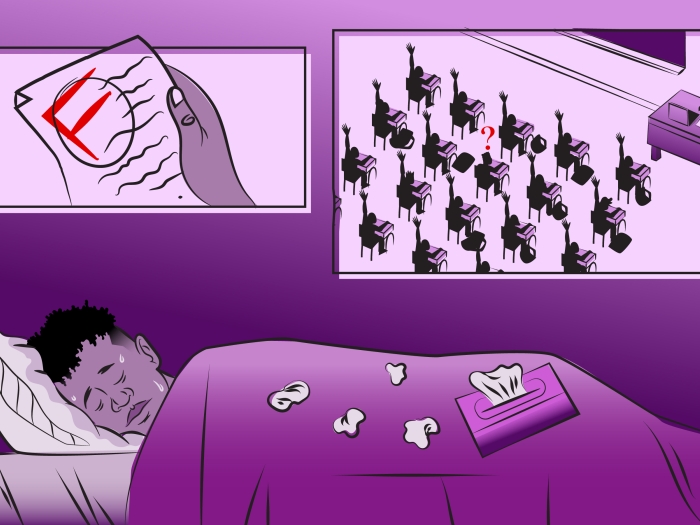An infectious disease expert answers questions about safely returning to school, especially if a child or family member has a health condition.
8:11 AM
Author |

Editor's note: Information on the COVID-19 crisis is constantly changing. For the latest numbers and updates, keep checking the CDC's website. For the most up-to-date information from Michigan Medicine, visit the hospital's Coronavirus (COVID-19) webpage.
After months of keeping children home with limited exposure to COVID-19, some parents may feel anxious about sending them back to school for the first time during the pandemic.
And for families of children with underlying health conditions or who live with a high risk loved one at home, it may be especially nerve-wracking.
The biggest question: Is it safe to send kids back to school during a pandemic?
Alison Tribble, M.D., a pediatric infectious disease specialist at Michigan Medicine C.S. Mott Children's Hospital recently addressed questions about infection risk and mitigation measures during a live back-to-school Q&A.
Here, Tribble answers some of parents' questions about safely returning to school:
Are children with underlying conditions, such as heart problems, at higher risk for COVID and will they have a harder time recovering?
Tribble notes that while older adults with underlying conditions, such as heart disease or diabetes, are high risk, there is limited data on how such conditions impact children's reactions to COVID-19.
In the absence of this definitive knowledge, Tribble says if children are frequently hospitalized with respiratory viruses, they may also be more likely to be hospitalized if they acquire COVID-19.
"Talking with your cardiologist or pediatrician who knows your child's situation is the best way to go," Tribble says. "We're learning more about this disease every day, and we may not have the best answers right now."
It's important to keep checking back, she says, because information continues to change.
The definition of safe is going to be different for every family and every situation, Tribble says. It's really about assessing the risks and benefits of the given situation and making a decision that's the right fit for each family.Alison Tribble, M.D.
Children seem to have mostly been spared from serious complications from novel coronavirus SARS-CoV-2. A little over 7 % of all cases of COVID-19 and less than 0.1 % of deaths have been reported among children, according to the Centers for Disease Control.
A small number of children (up to about 600) have also experienced a potentially fatal, but usually treatable, COVID-19 related disease called multi-system inflammatory syndrome (MIS-C.)
The good news: "In general, we're not seeing severe disease in kids, even kids who have underlying conditions," Tribble says, and the evidence so far doesn't point to any particular high risk pediatric populations.
How should families of children with underlying health conditions decide if and when children should return to school during COVID?
A team of Mott experts put together a back-to-school guide for children with underlying health conditions to help families make decisions that are best for them as well as guidance for siblings who go back to in-person school.
Doctors emphasize that current research still identifies adults over age 70, or with obesity, lung disease or other chronic illnesses at highest risk of serious illness.
Some children, such as those who have recently had transplants or undergone therapies that makes them more immunocompromised, are encouraged to discuss back to school plans with their healthcare team.
Melissa Cousino, Ph.D., a pediatric psychologist at Mott, along with members from the Pediatric Infectious Disease Society, created a resource to help guide families of transplant patients and children with other conditions.
Tribble says each family needs to make decisions about returning to school based on what's right for them. Multiple factors, such as having high risk adults at home with underlying conditions and the transmission rate in individual communities, may guide choices.
Is it safe for children with breathing issues like asthma to wear masks all day?
Yes. For children whose asthma is well-controlled, there are no harms in wearing masks all day, Tribble says. The gaps between mask fibers and around the edges of the mask allow for sufficient airflow so that there is no risk of buildup of carbon dioxide or deficiency in oxygen.
In very rare instances when a child is having breathing issues, they likely would be avoiding school in the first place.
MORE FROM MICHIGAN: Sign up for our weekly newsletter
All of the major medical associations who care for patients with asthma have issued a joint statement saying that people with asthma and other severe lung diseases should wear masks to help prevent the spread of COVID-19. Tribble notes potential benefits of mask wearing for people with asthma, such as reducing exposure to common asthma triggers, including common cold viruses, cold air and airborne allergens like pollen and animal dander.
Pulmonologists from Michigan Medicine, in partnership with the Michigan Department of Health and Human Services Asthma Program, also put together a guide for mask use for people with asthma or any severe lung disease.
How can I limit exposure from children attending school to family members at home?
Children should be wearing masks as much as possible and maintaining distance from people outside their household. Hygiene practices, such as regular and proper hand washing – especially before and after eating, touching their faces or using tissues – is also important.
At home, families may consider a "mask basket" for everyone to drop dirty masks in once they walk through the door. There's a very low risk of the virus being transmitted through clothes so changing clothes is unlikely necessary, Tribble notes. But washing hands after coming home is another good step to reduce exposure.
If children live with a high risk family member, families may also consider practicing distance within the home – such as wearing masks, quarantining to one part of the home and not sharing bedrooms, bathrooms or common areas for eating if possible, Tribble says.
What else should families know before children re-enter face-to-face school?
Parents should communicate with schools about what risk mitigation measures they're implementing, such as mask wearing, putting students in cohorts, rearranging classrooms for social distancing, using the outdoors for classes when feasible and enhancing sanitization practices.
Tribble notes that all of these steps are ways to reduce the risk of spreading the virus. While none is perfect alone, "each one adds a layer of protection"
She highlights that risk mitigation measures are primarily in place for children with no symptoms, which studies indicate make up an average of 0.6% (or less than 1 in 100 kids.)
If children have symptoms that could be related to the novel coronavirus, their parents have a responsibility to keep them home – which will help schools successfully stay open. If children develop symptoms, families should call their pediatrician for advice on testing and consult with their school on advice or policies about exclusion.
"The definition of safe is going to be different for every family and every situation," Tribble says. "It's really about assessing the risks and benefits of the given situation and making a decision that's the right fit for each family.

Explore a variety of healthcare news & stories by visiting the Health Lab home page for more articles.

Department of Communication at Michigan Medicine
Want top health & research news weekly? Sign up for Health Lab’s newsletters today!





